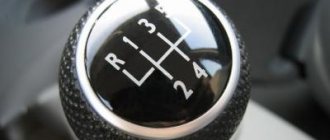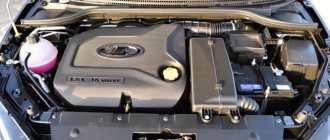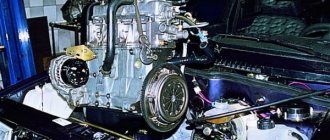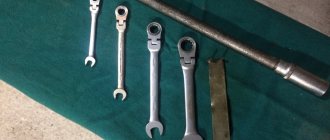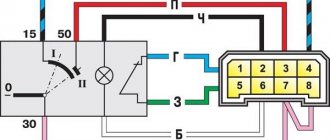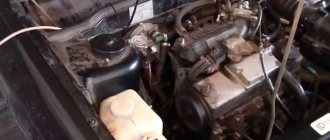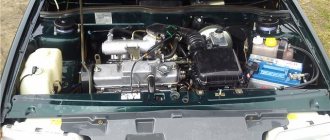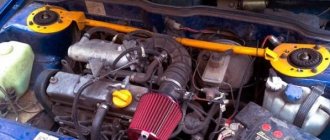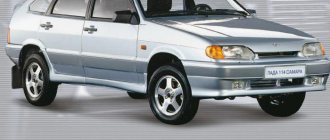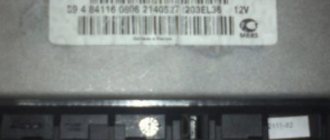General information about the car.
VAZ-2115 Samara-2 is a front-wheel drive sedan, the first representative of the updated Samara family of cars.
The VAZ 2115 car is the founder of the family codenamed Samara-2. The model range includes the 3-door VAZ 2113 hatchback, the 5-door VAZ 2114 hatchback and the VAZ 2115 sedan itself. The Samara-2 family is a modernization of the VAZ 2108, 2109 and 21099 models, respectively.
In 1997, the VAZ 2115 sedan began to be assembled at Pilot Industrial Production (EPP); in 2001, assembly began on the factory assembly line. Currently, the VAZ 2115 is on wide sale; three versions are available: standard (21150-20), norm (21150-21) and luxury (21150-22). In terms of price, the car occupies an intermediate position between the Samara and the tenth family.
The appearance of the car has noticeably changed - the front and rear parts have been changed, the interior has been updated, while the sides, doors and roof remain the same. The new model is distinguished by the front part of the body with original headlights, a modified shape of the hood and front fenders, new taillights with an insert between them, bumpers painted in body color, a trunk spoiler with an additional brake light, door moldings, door sill fairings, a new trunk lid with floor level connector. New efficient lighting technology is provided. The modernization has noticeably improved, modernized the appearance of the car, and also improved the aerodynamics of the car.
The interior of the VAZ-2115 car has become more comfortable, a new, more convenient and advanced instrument panel has appeared, which has a more streamlined and ergonomic shape, backlit push-button switches and indicator lamps (the so-called “European panel”), an adjustable steering column, a steering wheel from the “tenth” "family, "console" between the front seats. The new heater design provides efficient heating of the interior. The standard equipment includes an on-board driver warning system for closing the door locks, unfastened seat belts, leaving the ignition key in the lock, the level of oil and coolant in the engine, and extreme wear of the brake pads. The luggage compartment has become more spacious and convenient due to the increase in the trunk lid. The power units are similar to the VAZ-21099.
The cars use 1.5-liter gasoline engines, both carburetor and with an electronic fuel injection control system with a 5-speed manual gearbox. Initially, modifications with a carburetor engine were produced. In 2001, a modification of the VAZ 2115i was released with an injection (VAZ 2111) engine with distributed fuel injection. To increase service life and reduce noise at idle, a new clutch driven disc with an idle damper is provided.
Engine diagram and structure
General view of the engine
Before we begin to consider the issue of the engine design and description of the characteristics, it is necessary to consider the design of the components and parts that are located directly in the main power unit and outside.
Diagram and design of the Samara-2 engine
1 – generator drive pulley; 2 – oil pump; 3 – timing belt; 4 – toothed pulley of the coolant pump; 5 – front cover of the timing mechanism drive; 6 – tension roller; 7 – camshaft toothed pulley; 8 – rear cover of the camshaft drive; 9 – camshaft oil seal; 10 – cylinder head cover; 11 – camshaft; 12 – front cover of camshaft bearings; 13 – pusher; 14 – valve guide; 15 – oil separator mesh for the crankcase ventilation system; 16 – exhaust valve; 17 – inlet valve; 18 – rear cover of camshaft bearings; 19 – fuel pump; 20 – housing of auxiliary units; 21 – ignition distributor sensor; 22 – outlet pipe of the cooling jacket; 23 – cylinder head; 24 – spark plug; 25 – crankcase ventilation hose; 26 – flywheel; 27 – crankshaft rear oil seal holder; 28 – rear crankshaft oil seal; 29 – cylinder block; 30 – oil pan; 31 – oil level indicator (oil dipstick); 32 – crankshaft; 33 – piston; 34 – connecting rod cover; 35 – connecting rod; 36 – crankshaft main bearing cover; 37 – front crankshaft oil seal; 38 – crankshaft toothed pulley.
Also, it’s worth looking at a cross-section of the VAZ-2114 engine:
Cross section of the Samara engine
1 – oil pan drain plug; 2 – oil pan; 3 – oil filter; 4 – coolant pump; 5 – exhaust manifold; 6 – intake manifold; 7 – carburetor; 8 – fuel pump; 9 – cylinder head cover; 10 – camshaft bearing cover; 11 – camshaft; 12 – crankcase ventilation hose; 13 – valve adjusting washer; 14 – pusher; 15 – valve cotters; 16 – valve springs; 17 – oil scraper cap; 18 – valve guide; 19 – valve; 20 – cylinder head; 21 – spark plug; 22 – piston; 23 – compression piston rings; 24 – oil scraper ring; 25 – piston pin; 26 – cylinder block; 27 – connecting rod; 28 – crankshaft; 29 – connecting rod cover; 30 – oil level indicator; 31 – oil pump receiver
What is under the hood of the VAZ 2114
Under the hood of the VAZ 2114 its key mechanisms are located. First of all, this is an engine - four-cylinder, single-row, with 8 or 16 valves. From the receiver, compressed air enters it and passes through the air filter (to the right of the engine).
In addition, under the hood of the 2114 there are:
- The windshield washer reservoir is to the left of the engine.
- The hydraulic tank for the brake system is just above the air filter.
- The battery is in the lower right corner.
- The cooling system expansion tank is on the right, above the battery.
- Fuel system adsorber - between the hydraulic drive reservoir and the expansion tank of the cooling system.
- The gearbox is under the engine, on the right side.
The adsorber on the VAZ 2114 appeared in order to comply with Euro-2 and Euro-3 environmental standards. It is designed to capture spent fuel vapors that have not liquefied. With the help of an adsorbent (usually activated carbon), the vapors are absorbed. A malfunction of the device is indicated by a characteristic hissing sound when opening the fuel tank, and a drop in engine speed at idle.
Symptoms of malfunction
The malfunction of the water pump on the four can be determined by characteristic symptoms or a combination of them. Most often this is evidenced by:
- Coolant smell in the cabin. This symptom may indicate a pump failure. But the characteristic “amber” can also occur with other malfunctions.
- Frequent overheating of the motor. The vehicle's dashboard will indicate that the engine temperature is too high. Under normal conditions, it should not exceed 90 degrees.
- Uneven or regular wear on the timing belt. The crankshaft pulley may also look very worn.
- Coolant leak near the pump and timing belt. Traces of this liquid may be visible in the engine compartment and under the car. It is worth noting that sometimes the problem occurs when the oil seal wears out or is installed incorrectly.
- Pump noise and vibration. Unpleasant sounds are heard from under the hood when the engine is running. This symptom does not always indicate a failure of this part; it can also be caused by other reasons.
The appearance of one or more of the above symptoms or a combination of them is a reason to immediately check the pump. After all, its breakdown is very dangerous. As a result, the timing belt may break and, as a result, the valves and pistons of the engine will meet if the pistons are installed without recesses. The motor will jam. And only expensive and complex repairs will help restore its functionality.
The service life of the part for this AvtoVAZ model is about 100,000 km. But sometimes it can break even earlier. Therefore, on long runs, it is recommended to regularly monitor its operation.
Adjusting the hood latch is easy to do with your own hands
Let's take a closer look at the hood of our car
Has there been any strangeness in his behavior? Often we do not pay attention to such little things as the fact that the hood has become a little worse to close, more and more effort is required each time to open it, and a rattling noise has appeared (at first light and intermittent). After all, all this happens gradually, and therefore imperceptibly
We forget about such a simple matter as adjusting the hood latch.
Timely diagnosis is the key to safety
We notice a flat tire or a “sick” starter immediately and take urgent measures to eliminate the problem. And a tired hood lock, according to most car enthusiasts, “does not affect speed.” Indeed, it does not affect, but many are terribly annoyed by repeated clapping, nervously tugging at the handle in the hope that Sesame will finally open. And all this happens, as a rule, at the most inopportune moments. It seems like a small thing, but an irritated driver is a threat on the road, and for absolutely all road users.
Or a hood that opens of its own accord while driving... Even at low speed this can create serious problems.
Let’s not put off such a “trifle” as adjustment. Moreover, all operations can be performed independently, without resorting to the help of service station workers, and most importantly, completely free of charge!
And this happens sometimes!
What does the price depend on?
Motorists who need engine overhaul of a VAZ-2114 are faced with different prices for such a service. The cost depends on the influence of factors:
- Engine capacity.
- The prestige of the service company, its pricing policy.
- Urgency.
- Scope of work.
- Difficulty of repair.
- The need for a specialist to visit.
- Cost of spare parts.
- Equipment used.
- Automotive technician qualification level.
The more work is required to restore the engine of a VAZ-2114 car, the more expensive the service of a specialist will cost. You will have to pay extra for urgency and a specialist visit.
How to change the engine on a VAZ 2114
The VAZ 2114 engine changed throughout the entire production period of this car. The first models of the VAZ 2114 or “Samara-2” (as it began to be called by analogy with its predecessor) rolled off the production line with an engine from the VAZ 2109. It was an eight-valve injection engine with a relatively small volume - only one and a half liters. This engine did not differ in terms of developed power, which was 78 horsepower.
Since 2007, VAZ 21114 engines began to be installed on cars, with an increased volume of 1.596 liters and a maximum power of 80-84 hp. With. This engine complied with the Euro-3 environmental standard.
And since 2010, a model with a 16-valve engine has been produced. It's also a four-cylinder engine, but instead of two valves per cylinder there are four. The 16-valve engine has more power - 98 horsepower, faster acceleration, but is more susceptible to breakdowns than the eight-valve engine.
Thus, under the hood of the VAZ 2114 there are key mechanisms, the main one of which is the engine. Its operation is based on a distributed fuel injection system, which is regulated by an electronic control unit.
Latest comments:
- Igor: I don’t have a fitting, the throttle is electronic, what should I do?
- Denis: Hello everyone. On the ventilators, what should the wires be attached to?
- Vova: I did everything as in the picture, except I didn’t install a new cigarette lighter. P [. ]
- Mukhtar: Guys, salamaleikum to everyone, I have such a problem with the arrows on the panel and im [. ]
- Vitaly: Hello, I have a VAZ 2115. I recently encountered such a problem with [. ]
Another video with an example of replacement
https://youtu.be/QxX3tCjapJE
The VAZ-2114 car uses a hidden engine cooling circuit with an injector. It is highly complex and includes 28 elements. Traditionally, the assembly of the cooling system of this car is not of high quality. Therefore, throughout the entire period of operation, it requires constant monitoring, regular maintenance and repair. In this regard, many owners of this car are interested in the nuances associated with independent maintenance, repair and operation of the cooling system, among which the most common questions are:
- 1. How to properly replace the coolant mixture?
- 2. How to flush the cooling system?
- 3. How to remove air from the VAZ-2114 cooling system?
- 4. How to properly replace the cooling system pipes?
How to ensure ease of opening and reliable fixation?
For these purposes, a special part is sold that can be installed on the car yourself. This part is called a gas stop. They replace the standard rack and, as a result, the consumer properties of the car increase sharply. The opening of the hood begins as follows. You only need to lift the hood a little with one hand. Next, the gas stop gets to work. He himself will raise the hood to the required height and securely fix it there. The standard stop will no longer be used. During operation, this stop does not require any maintenance.
Many owners of VAZ 2114 cars prefer to install a gas strut on their car, especially since the installation process does not require much effort. To perform this operation you will need:
- The stops themselves;
- Two keys for 13;
- Four nuts with washers for 13mm;
- Drill;
- Eight-millimeter drill;
- A little enamel and bitumen.
In this case, the internal distance between the two holes will be 310 millimeters. The holes will be drilled into the thickening of the hood, inside of which there is a void. Nevertheless, the procedure should be approached with all responsibility, because if you overdo it, you can drill a hole in the hood itself. After making sure that everything is marked correctly, we proceed directly to drilling. Using a drill you need to make four holes. Two in the hood thickening and two under the hood, one on each side of the body cross member. To prevent the possibility of corrosion, it is advisable to treat the resulting holes with an anti-corrosion compound and paint. After this, you can proceed directly to the installation. We take the gas stop and install it in the drilled holes on one side. We do the same with the second emphasis. They will need to be screwed. For those who work without an assistant, it is better to first screw the stops onto the hood, and only then onto the body. If there is someone nearby who can support the hood, then the sequence of actions does not really matter. When everything is done, it will be possible to test the set stops in action. You will need to try opening and closing the hood several times. It should open easily and smoothly, and closing should not be accompanied by significant effort.
VAZ 2115 fuse diagram
The most common models are 3722010 (since 2004) and 21150 3722 010 10. The set of protective elements of electrical equipment in them is not very different from each other, but there are differences, and they are reflected in the decoding of the diagrams below.
The main mounting block under the hood of the car.
| Item no. | Power, A | What protects |
| 1 | 10 | Lamps for rear fog lights and PTF turn-on indicator |
| 1* | 10 | Headlight cleaner motor and relay (contacts). Headlight washer activation valve |
| 2 | 10 | Turn signals, breaker relay and hazard warning lamp |
| 3 | 7.5 | Interior lighting front, center, trunk Ignition switch Engine management system Brake lamps On-board computer |
| 3* | 7.5 | Rear lights (brake light) Body interior light |
| 4 | 20 | Cartridge for connecting a portable lamp Heated rear window (contacts) |
| 4* | 20 | Cigarette lighter Socket for portable lamp |
| 5 | 20 | Horn Cooling fan motor |
| 6 | 30 | Power windows Power relay (contacts) |
| 7 | 30 | Heater motor Windshield washer Headlight wiper motors (in operating mode) Cigarette lighter Glove compartment lamp Rear window heating relay (winding) |
| 7* | 30 | Headlight wiper motor Winding Heater motor Window washer Rear window wiper motor Windshield and rear window washer activation valve Cooling system fan activation Rear window heating relay coil Indicator lamp Glove compartment lighting |
| 8 | 7.5 | Right PTF |
| 8* | 7.5 | Left PTF |
| 9 | 7.5 | Left PTF |
| 9* | 7.5 | Right PTF |
| 10 | 7.5 | Left dimensions License plate lamps Engine compartment lamp Instrument lighting switch Illumination lamps for switches, instruments, cigarette lighter, ashtray, heater control levers Illumination panel for heater levers |
| 11 | 7.5 | Right dimensions |
| 12 | 7.5 | Right low headlight |
| 13 | 7.5 | Left |
| 14 | 7.5 | Left high beam headlight High beam indicator lamp |
| 15 | 7.5 | Right high beam |
| 16 | 15 | Turn signals, relay-breaker for turn signals and hazard warning lights (in turn signal mode) Reversing light lamps Lamp health monitoring relay On-board monitoring system display unit Instrument cluster Insufficient oil pressure lamp Parking brake activation lamp Brake fluid level lamp Battery low warning lamp Trip computer ( if installed) Generator field winding (in engine starting mode) |
| 17 | — | Reserve |
| 18 | — | Reserve |
| 19 | — | Reserve |
| 20 | — | Reserve |
The asterisk indicates older configurations. Relay
| K1 | Headlight cleaners |
| K2 | Turn signal and hazard warning switch |
| K3 | Wiper |
| K4 | Lamp integrity |
| K5 | Window lifters |
| K6 | Sound signals |
| K7 | Heated rear window |
| K8 | High beam |
| K9 | Near |
Additional unit in the cabin
| Circuit breakers | Power, A | What is he responsible for? |
| 1 | 15 | Main relay |
| 2 | 15 | Constant power supply to the controller |
| 3 | 15 | Fuel pump |
Relay
| K4 | Fuel pump |
| K5 | Cooling fan |
| K6 | Main relay |
Starter fuse and relay
The VAZ 2115 retractor should be looked for on the device itself. To check it without removing the device, lift the hood cover and place it between the fan radiator and the engine. On diagrams it is often referred to as a blocking switch. The contact protection relay is called additional. The photo shows what it looks like.
Cigarette lighter fuse
It is numbered F4 with a rating of 20 Amps. The new ones are marked as F7 with a power of 30 A. The element often does not work due to short circuits.
Fuel pump fuse and relay
Placed in an additional interior mounting block under the glove compartment. The first is marked as F3 and its power is 15 A, and the number of the second is K4.
Where is the relay and ignition fuse located?
It is located in the cabin, under the instrument panel on the driver's side.
VAZ 2115 heater fuse: where is it located?
F7 and rated at 30 Amps is placed in the cabin.
Fan
The relay was placed in an additional block under the glove compartment - K5. The insert is located in the main block - F5 with a rating of 20 Amps.
Generator
A three-level voltage regulator relay was placed on the installation. It can be seen right next to the wires coming from the latter.
Turn signal relay
Lada 2115 has been marked K2 since 2006. Located in the engine compartment mounting block.
Heated rear window
The answer is F4, with a power of 20 A.
Windscreen wipers
Fuse element number F7.
Stop signals
F3 rated 7.5 Amps.
Radio tape recorder
The fusible protective element of the tape recorder is F5 and rated at 20 Amps.
Reverse fuse
Located in the main mounting block - F16.
Idle relay
Located on the throttle assembly.
Wipers
This is #3. The main signs of its malfunction are a sudden stop of the windshield wipers and their intermittent operation.
Lamp health monitoring relay
No. 4 in the main block.
Where is the fog light relay located?
Located on the fender near the battery. Or trace its position through the wires from the fogs themselves.
Which fuse is responsible for the power windows on the VAZ 2115
Primary installer element F6, rated 30 A.
Low and high beam
4 elements rated 7.5 Amps. Designated - F12, F13, F14, F15 - right and left low beam, and for high beam.
Interior lighting
No. 3 at 7.5 A is responsible for it.
Charger
The battery fuse is installed on the battery.
central locking
You need to determine the location of the wiring harness going to the installer, where the insert is located.
Emergency crew
No. 2 in the main block. Rating - 10 A.
Dimensions
The protection elements are designated F10 and F11 and both are rated at 7.5 A.
Instrument panel fuse
No. F16 and rated at 15 A.
Instrument lighting
Comes complete with 7.5 A dimensional protection in F10.
Number plate illumination
No. F10 at 7.5 Amperes.
Windshield washer fuse
No. F7 and rated at 30 Amps.
ECU relay
No.
Fuse F3
Responsible for protecting the interior lighting circuits, instrument lighting, brake warning lights and, in some versions, the on-board computer. Nominal - 7.5 A.
Fuse F7
The fusible element in the VAZ 2115 is responsible for the headlight and glass cleaners, washer, glove compartment lighting and stove. Its power is 30 A.
VAZ 2115: fuse F10 is on
The fusible element is responsible for the left dimensions; it burns out for one reason - the metal frame of the dashboard frays the wiring and a short circuit occurs. To solve the problem, it is necessary to insulate and secure the cable.
Fuse F16 is on
An element rated 15 A is one of the most important in the VAZ 2115 - it is responsible for a huge number of circuits, from turn signals to alarms. The burnout is due to poor performance of the reverse sensor - the factory one requires replacement.
Fuse for on-board computer
The element takes the place of F3 with a rating of 7.5 A or F16 with a rating of 15 A in the main block.
Relay K4 VAZ 2115: what it is responsible for
Responsible for the proper operation of headlight lamps. Located under the hood with number 4.
What do the tidy indicators do?
The control panel on the VAZ 2115 is located in the center console directly in front of the driver.
Descriptions of instrument cluster symbols are given below:
- Coolant temperature sensor, if the controller arrow moves into the red zone, this indicates that the power unit is overheating.
- A tachometer informs the driver about the crankshaft rotation speed; if the arrow falls into the red zone, it is necessary to reduce the engine speed.
- Left turn signal.
- Right turn signal.
- A speedometer that tells you how fast a vehicle is moving.
- Fuel level sensor in the tank.
- The light indicator, made in the form of a gas pump, usually lights up if there is no more than 7 liters of fuel left in the gas tank.
- Optics indicator, activated when the side lights are turned on.
- In accordance with the instructions, an indicator in the form of an exclamation mark lights up on the instrument panel if the brake fluid level has dropped and reached a minimum.
- High beam activation indicator light.
- This is a button designed to reset the daily mileage on the odometer and set the clock.
- An odometer that records the mileage of a vehicle.
- Light alarm, when turned on, this indicator will blink.
- The icons include one important indicator - Check Engine. This symbol always flashes when the engine starts, but disappears after it starts. The indicator may appear if the control unit detects certain problems in the operation of the power unit.
- The display showing the outside temperature and time is switched using button 11.
- The battery icon appears when the ignition is turned on; if it is constantly on, then most likely the on-board computer has detected problems related to the battery charge. But if it occurs, the problem may also be caused by a malfunction of the generator, loosening of the strap, or breakdown of the unit.
- The letter P in a circle - the indicator appears when the car is setting the parking brake.
- This symbol lights up when the engine fluid pressure is too low.
- Reserve indicator (the author of the video about tuning the control panel at home is the Studio Pandora channel).
https://www.youtube.com/watch?v=QxX3tCjapJE
Immediately after purchasing a car
So, you have become the happy owner of your own car, moreover, not a used one, but a brand new one, which brings much more positive emotions than buying a used foreign car at the same price. First of all, you should pay attention to anticorrosive. The bottom of the car and wheel arches come out of the factory without protection, so either contact a service station or take the time to buy plastic protection and a can of bitumen mastic. But you should not blindly trust the service station; always check the quality of the service provided.
new VAZ 2114 cars
After you have dealt with the car body, you should take up the wrenches and check the tightness of the nuts and bolts, at least those that can be obtained without unnecessary difficulties. The fact is that the domestic manufacturer has such a sin as loose bolts and nuts, which create unpleasant rattling noises.
Run-in
Warming up a new engine is a very important stage, and it is not necessary to wait until the temperature reaches operating 80 degrees; it will be enough to overcome the lower limit of 40 0 C. If the car has not yet been run-in, then be sure to monitor the speed and do not load it with sudden accelerations, especially in a cold state.
During the break-in process, the engine pistons undergo final grinding, and if the engine is not warmed up, then as a result, not all elements will go through the thermal expansion phase, which will lead either to their rapid, uneven wear or to engine seizure.
Signs of breakdown
If, when you turn the ignition key, the electric starter does not spin, but you can hear soft clicks of the relay contacts operating, then the cause of the car malfunction is the starter. You can verify this by connecting it directly to the battery, bypassing this electric relay. If clicks are not heard, and the starter is working properly, then it’s time to change it.
